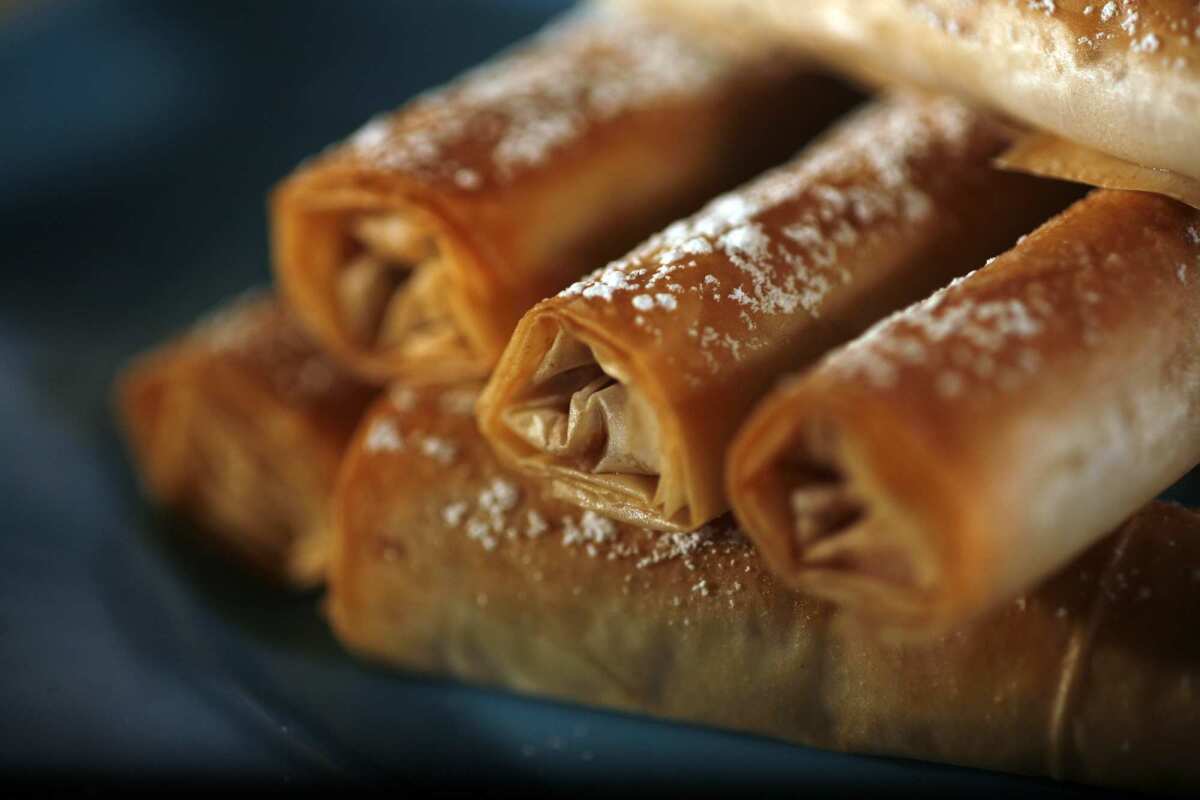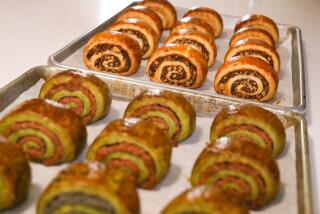Recipe: Haman’s fingers

Haman’s fingers
Total time: 1 hour, 20 minutes
Servings: This makes 36 to 40 pastries.
Note: To thaw the filo dough, place the package in the refrigerator for at least 8 hours and up to overnight. Remove the box from the refrigerator 2 hours before using, leaving the sheets in their packaging. (Return remaining filo sheets to their plastic sleeve, re-roll and return to the package; refrigerate or refreeze until needed.) You can keep the pastries for 1 day in an airtight container at room temperature; they can be frozen up to 1 month (thaw the pastries before sprinkling over the powdered sugar). Pareve margarine can be found at kosher markets.
1 cup whole almonds, with skins (about 5 ounces)
1/4 cup pine nuts or additional almonds
3/4 cup walnuts (about 2½ ounces)
1 1/4 teaspoons ground cinnamon
3 tablespoons plus 1½ teaspoons powdered sugar, sifted, plus 2 to 3 tablespoons additional powdered sugar for sprinkling
About ½ pound filo dough
8 or 9 tablespoons canola oil or melted vegan or pareve margarine
1. Place the almonds in a food processor. (If using extra almonds instead of the pine nuts, add these to the processor; if using pine nuts, do not add them as they should be left whole.) Pulse the processor to chop the nuts; do not grind the nuts to a powder, there should be some small pieces left. Place the chopped nuts in a medium bowl, then pulse the walnuts in the same way. Add the chopped walnuts to the bowl with the almonds.
2. Add the pine nuts, cinnamon and 3 tablespoons plus 1½ teaspoons powdered sugar to the bowl, stirring to mix thoroughly.
3. Lightly oil 2 baking sheets, or line them with parchment paper or foil and lightly oil the paper.
4. Remove the filo sheets from the package and unroll them onto a sheet of plastic wrap. Cover the remaining stack immediately with plastic wrap, then with a slightly damp towel. (Return filo sheets you won’t use to their plastic sleeve, re-roll and return to the package; refrigerate or freeze for other uses.)
5. Transfer the stack of filo to a completely dry cutting board. With a sharp knife, cut the stack of filo into rectangles about 8½ inches in length and 6 inches wide (Sheet size will vary by brand; filo sheets measuring 17 inches by 12 inches should be quartered to form smaller rectangles, sheets measuring 12 inches by 9 inches should be halved.)
6. Remove a pastry piece from the stack to a work surface. Brush the piece lightly with oil, beginning with the edges; avoid getting oil on the work surface, as it would make the dough stick. Work with only one sheet at a time, keeping the remaining sheets covered so they don’t dry out.
7. Spoon about 2 teaspoons filling along the short end of a filo piece so that the filling extends along the short edge, leaving about three-fourths inch free of filling on each side. Roll the filling into the filo as you would a very thin burrito: Fold the two longer sides of the dough rectangle inward, covering the filling by about 3/4 to 1 inch on each side. Dab the folded dough lightly with oil. Roll the pastry tightly to form a thin finger. Set the pastry seam-side down on a prepared baking sheet. Brush the pastry finger lightly with oil.
8. Make more filo fingers with the remaining dough and filling. Wipe the work surface with a paper towel once in a while so it does not become oily. You can shape the pastries 1 day ahead and refrigerate them, tightly covered with plastic wrap, on baking sheets or on plates; or you can freeze them, tightly covered, up to 1 month.
9. Heat the oven to 350 degrees. Bake the pastries until golden, about 8 to 10 minutes. Cool them on a rack.
10. Just before serving, shake or sift powdered sugar generously over the pastries.
Each of 40 pastries: 85 calories; 2 grams protein; 5 grams carbohydrates; 1 gram fiber; 7 grams fat; 1 gram saturated fat; 0 cholesterol; 1 gram sugar; 28 mg sodium.
More to Read
Eat your way across L.A.
Get our weekly Tasting Notes newsletter for reviews, news and more.
You may occasionally receive promotional content from the Los Angeles Times.






